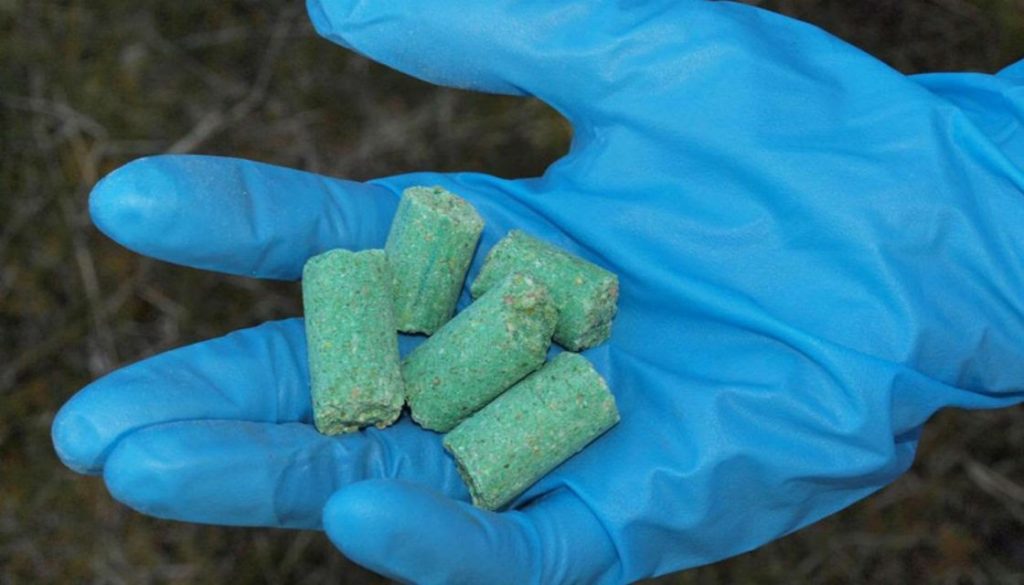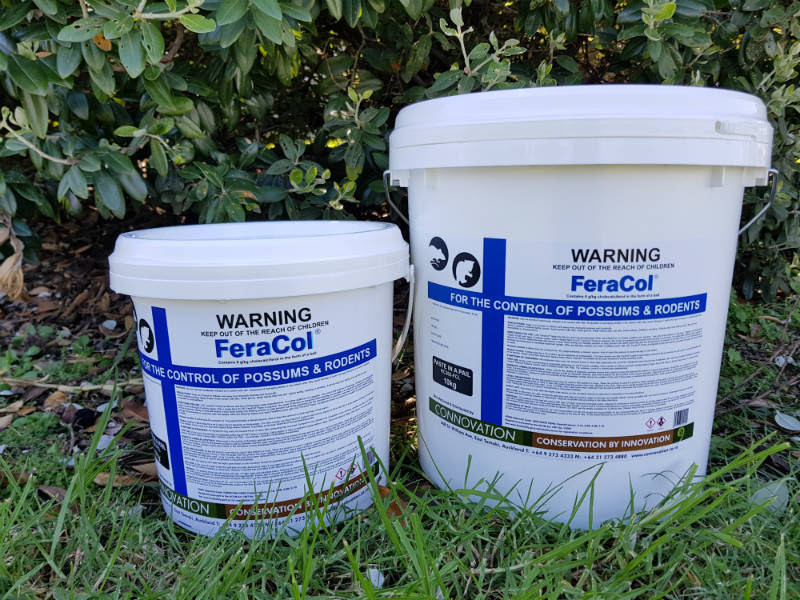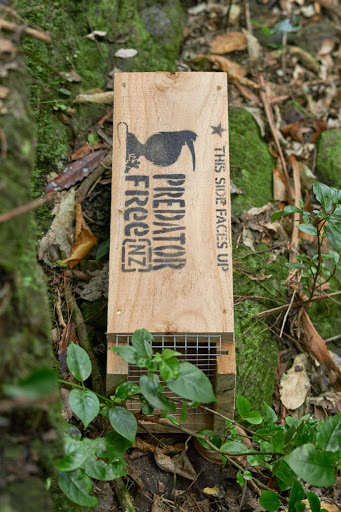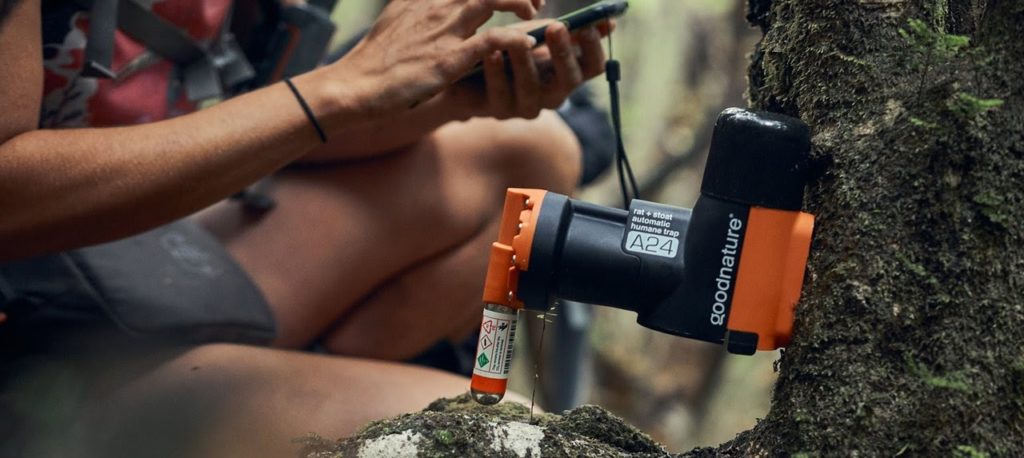Overuse of the same tool will reduce its effectiveness. Tool selection depends on each situation: habitat, scale, which predators are present and how much time and money you put into it. For the best chance of success, you’ll also need to team up with your neighbours.
ON THIS PAGE
Toxins
Pros
- Effective over large areas with dense predator populations.
- Can save time, money and resources.
Cons
- Personal risk of handling toxins, risks to other animals on the farm and to the wider environment.
Tips for best use
- Contain in weather resistant bait stations (e.g. Philproof Tamperproof Rodent, Pestoff Easy-Feed, Sentry).
- Secure bait blocks on pins so rats can’t carry off and store.
- Use late winter through to early spring when predators increase and threaten nesting and fledging birds.

- Instead of baiting year-round, ‘pulse’ your bait at key times to save money and avoid bait shyness (effective pulsing times are usually four times a year in August, November, January and April).
- Remove bait after 2 weeks to avoid predators encountering rotten or mouldy bait (adding to bait shyness). For best practice when disposing of bait, check the product label.
- Bait station spacing will depend on your target animal, toxins used and habitat. Adequate coverage is important.
Risks
- Carefully consider any potential effects of toxins on your farm! Desirable wildlife and livestock must not have access to baits.
- Some toxins may build up in the environment and may kill or harm other animals or wildlife through eating baits (primary poisoning) or by consuming poisoned animals (secondary poisoning).
- Follow label instructions, use Personal Protective Equipment, post appropriate warning signs, contain toxins in bait stations, and keep bait stations away from stock and pets. If you suspect poisoning, call the National Poisons Centre on 0800 POISON.
Types of toxins
Acute toxins (fast acting: e.g. 1080, cyanide)
- Controlled Substance Licence (CSL) required.
- Animal feels effect within minutes.
- Requires pre-feeding to get good results.
- Risk of bait shyness — bait shy predators are hard to catch and so are their offspring!
- No antidotes.
- Secondary poisoning risk for some acute toxins.
Chronic toxins (slow acting: e.g. anticoagulants)
- No CSL required.
- Animal doesn’t feel effect for days so does not associate feeling ‘unwell’ with eating bait.
- Weaker first generation anticoagulants (Pindone, Ditrac, Contrac) require multiple feeds over several days.
- More powerful 2nd generation anticoagulants (Pestoff) need just one feed.
- Antidote available.
- Second generation anticoagulants can be persistent in the food chain, so be careful if wild or domestic pigs are present.
Cholecalciferol (Vitamin D3) (Feracol and DECAL)
- No CSL required.
- Fits in between acute and chronic.
- Predators lose appetite after 20–30 mins.
- Pre-feeding required to avoid bait shyness.
- No secondary poison effects.

Trapping

Pros
- Useful for ongoing control once predator numbers are knocked down by toxins and/or night shooting.
- Less hazardous than toxins.
- Also useful for assessing predator presence/abundance (monitoring).
Cons
- Most kill traps only kill one predator at a time.
- If predator numbers are high, trapping can be time consuming and less effective than toxins.
- A trap ‘scare’ (from an incorrectly set trap) can make predators trap shy.
- Traps can be dangerous to non target species such as kiwi and weka.
Tips for best use
- Kill traps (e.g. DOC 200 box traps, Timms, Sentinel, Warrior) can be set and left for a period of days or weeks between checks. Check frequently — at least every 2 weeks if possible, but more in spring and summer when predators are more mobile.
- Goodnature Smart Traps are self setting traps that can catch multiple predators before being rebaited so can be left longer between checks (1–3 months).
- Leg-hold or live cage traps must legally be checked every day.
- Traps must use attractive lures/baits to encourage predators in. A combination of visual and odour attractants work best.
- Trap spacing depends on your target animal and habitat situation.
- Target obvious animal runs (tracks) along and under fence lines, bush edges, the side of buildings, along road or track edges, around culverts, bedside streams or log crossings.
- Attention to detail is important. Set every trap like your life depends on it — every time! A trap-shy predator will be hard to catch and so will their offspring.
- Keep traps clean and well maintained.
- Putting traps in place one month or so prior to the trapping operation will reduce the natural caution that predators show towards new objects in their habitat.
- If a trap consistently fails to register a catch, moving it a few metres can make a big difference.
- Take care to ensure that wildlife and livestock cannot be trapped. Where necessary, use trap covers or raised sets to reduce the risk to non target species.

Shooting
Pros
- Useful for possums (other predators can also be targeted, e.g. feral cats).
- Night-shooting possums in spring is effective when favoured food such as willow or larch buds are just starting.
- Possums are easily detected in ‘naked’ trees.
- Large areas can be covered quickly.
Cons
- Shooting is ineffective for rodents and mustelids.
- Limited application in bush country.
For more information
For more information on predator control specific to your area, we recommend that you contact a predator control expert, your regional council or local DOC office.
For information on what you can do to take your trapping to the next level, download a Predator Control Annual Calendar (PDF, 102KB) or buy an A2 print from our shop.

